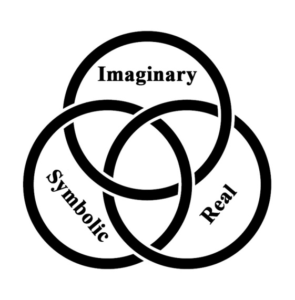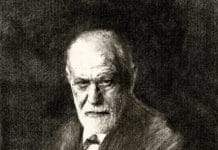The aim of this article is to introduce the reader to the general outline of Lacanian psychoanalysis by providing a rudimentary introduction to some Lacanian concepts such as the Lacanian triad (of the Imaginary, the Symbolic and the Real) and the concept of the big Other. We will also have a brief look at Lacan’s stance on psychoanalytic practice in order to explain how Lacanian psychoanalytic practice differs from other traditions.
The shaping of the subject by the analyst’s ego serves merely as an excuse for the analyst’s narcissism. –Lacan, 2006, 228
Historical background
Lacanian psychoanalysis could be viewed as a part belonging to a broader movement that was going on during the previous century. All intellectual movements, no matter how diverse, followed more or less the same path in the 20th century. Concerns about language became to dominate the intellectual atmosphere from Carnap to Heidegger and from Searle to Derrida. The analytic and the continental traditions both developed unique ways of dealing with language, and psychoanalysis was not exempt from such endeavours. The most predominant figure to take up this challenge was Jacques Lacan. Lacan introduced the innovative method of reading Freud under the light of structuralism which was sometimes accompanied by Hegelian, Marxian or Heideggerian twists. He saw it essential to “return to Freud”, and emphasised the prominence of Freud over all other psychoanalysts. His advice to all psychoanalysts was that “we can do no better than return to Freud’s work” (2006, 228). This return to Freud had to be a linguistic return to keep up with his times, but he did not go on reciting Freud word for word without bringing any originality into Freud’s texts; he started to read between the lines and restructured the edifice Freud had built in a unique way in order to make it fit his own understanding of psychoanalysis.
Lacan´s innovations
One might wonder why the linguistic reading of Freud was viewed as necessary by Lacan. From one perspective, it all has to do with truth:
The meaning of a return to Freud is a return to Freud’s meaning. And the meaning of what Freud said may be conveyed to anyone because, while addressed to everyone, it concerns each person. One word suffices to make this point: Freud’s discovery calls truth into question, and there is no one who is not personally concerned by truth. (Lacan, 2006, 337)
Nevertheless, according to Lacan, it is not possible to arrive at truth outside of language: “the dimension of truth emerges with the appearance of language” (2006, 436). Therefore, emphasis on language is at the heart of Lacanian psychoanalysis, so much so that the lingual dimension comes to form one of the three “elementary registers” which Lacan calls the Symbolic, the Imaginary and the Real. Such a distinction is unique to Lacanian psychoanalysis, and it is absolutely crucial for any reader of Lacan to have a basic understanding of each of these three orders. Lacan uses the Borromean knot to explain the structure of this triad. What is unique about the Borromean knot is that “the knot enjoys the Borromean property that if I cut any one of the rings that I have arranged in this way, all the others are set free” (1999, 130). This topological figure is meant to show the interrelation and interdependency of these three registers; the point is that if you untangle one of the circles, the whole structure will fall apart. The way we perceive reality is absolutely dependent upon the relations these three registers have with one another; metaphorically speaking, “it suffices for you to cut one for the other two to be set free” (1999, 124). Therefore, if the connection between any one of the circles with the other two became somehow interrupted, what we recognise as “reality” would become disturbed.
To put it concisely, the Imaginary deals with appearances and our interpersonal relations with other people; for instance, our everyday interactions with other people are reliant on the imaginary order, and notions such as “love” are more or less reducible to this order. The Symbolic forms the dimension of what has been signified and is meaningful to an individual – it is, in a sense, the lingual dimension; when you are born, you find yourself in a pre-established social structure and you adapt yourself to the specific culture of that society where people’s interactions are mediated by a pre-given language; such structures are all parts of the symbolic order. The Real (which should not be confused with reality) is that which has remained un-symbolised; throughout our lives, there are things which resist symbolisation (meaning, we cannot make any coherent sense out of them that would ultimately agree with the picture we have of the rest of our reality) such as traumas; such un-symbolised gaps in the Symbolic belong to the Real.
In order to demonstrate why it is absolutely essential for an analyst to be able to make a distinction between these three registers we can focus on the two registers of the Imaginary and the Symbolic. In his first Seminar, Lacan explains how Jung fails to make the necessary distinction between these two registers. Lacan (1991) considers psychosis and neurosis to be structurally different:
In the refusal to recognise [méconnaissance], in the refusal, in the barrier opposed to reality by the neurotic, we note a recourse to fancy. Here we have function, which in Freud’s vocabulary can only refer to the imaginary register. We know the extent to which people and objects in the neurotic’s milieu change significance entirely, in relation to a function there is no problem in naming – without going further than ordinary linguistic usage – as imaginary. […] Freud emphasises that nothing comparable is to be found in psychosis. When it comes to the psychotic subject, if he loses the realisation of the real, he doesn’t find any imaginary substitute. That is what distinguishes him from the neurotic. (116)
The psychotic relates to reality in a different manner: “When the psychotic reconstructs his world, what is invested to start off with? […] the answer is words. There, you cannot but recognise the category of the symbolic” (1991, 116–117). Consequently, without making a distinction between the Imaginary and the Symbolic, the analyst cannot deal with neurosis and psychosis properly. Lacan (1991) claims that Freud perfectly understood such a crucial distinction, whereas Jung fails to do so:
According to the Jungian schema, psychic interest comes and goes, goes out, comes back, colours, etc. It drowns the libido in the universal magma which will be the basis of the world’s constitution. […] It’s a pretty metaphor, but it throws no light on practice, as Freud underlines. It does not allow one to grasp the differences that there might be between a directed, sublimated retreat of interest in the world which the anchorite may achieve, and that of the schizophrenic, whose result is however structurally quite distinct, since the subject discovers that he is completely stuck. (115–116)
The introduction of the symbolic order into psychoanalysis enables Lacan to break free of the traditional movements in psychoanalysis; before Lacan, psychoanalytic practice was mostly focused on a dyadic relation between the ego of the analyst and the ego of the analysand; meaning, the analyst does not take the symbolic order into consideration and tries to reduce the analysis to the Imaginary. By taking the figure of the big Other into account this dyadic relation breaks down because the analysis is no longer confined by the interaction between two egos, and the Other (the Symbolic) has been taken into consideration. By taking the figure of the big Other into account this dyadic relation breaks down. Therefore, another crucial distinction in Lacanian psychoanalysis is the difference between the little other (autre), or simply the other (written with a lowercase o) and the big Other (Autre), or simply the Other (written with a capital O). The (little) other is situated in the Imaginary and it is mostly involved in interpersonal relations and their consequences such as identification; on the contrary, the (big) Other is situated in the Symbolic. We all address ourselves to this unknown figure of the Other; every action we perform is virtually a message addressed to the Other, and it is this unknown Other that defines our reality. Not only an analyst has to take into account the Other, but he also has to elevate himself to take the place of the Other in psychoanalytic practice. In his seminar on Freud’s Papers on Technique (1991), Lacan criticises Anna Freud for overemphasising the role of the ego in psychoanalysis:
Anna Freud’s point of view is intellectualist, and leads her into putting forward the view that everything in analysis must be conducted from a median, moderate position, which would be that of the ego. For her everything starts with the education or the persuasion of the ego, and everything must come back to that. (67)
What Lacan is really criticising is Anna Freud’s failure in making a distinction between dyadic interpretation in practice and an “interpretation which moves forward in the direction of the symbolic structuration of the subject, which is to be located beyond the present structure of his ego” (1991, 65). Lacan sarcastically remarks, “since it is argued that one is trying to bring about the patient’s readaptation to the real, one really ought to find out if it is the analyst’s ego which offers the measure of the real” (1991, 18).
Conclusion
By such attempts as trying to strengthen the subject’s ego, the analyst is performing a narcissistic act of trying to model the analysand’s ego after himself. Lacan argues that it is only by taking the place of the Other that the analyst becomes able to do proper analysis, and “any other place for the analyst leads him back to the dyadic relation, which has no other outcome than the dialectic of misrecognition, negation, and narcissistic alienation that Freud repeatedly indicates throughout his work to be the ego’s doing” (2006, 379).
References
- Lacan, J. (1991). Freud’s papers on technique, 1953-1954: The seminar of Jacques Lacan, Book I, W. W. Norton & Company.
- Lacan, J. (1999). On feminine sexuality, the limits of love and knowledge: The seminar of Jacques Lacan, Book XX: Encore, W. W. Norton & Company.
- Lacan, J. (2006). Écrits, W. W. Norton & Company.






Absolute gibberish.